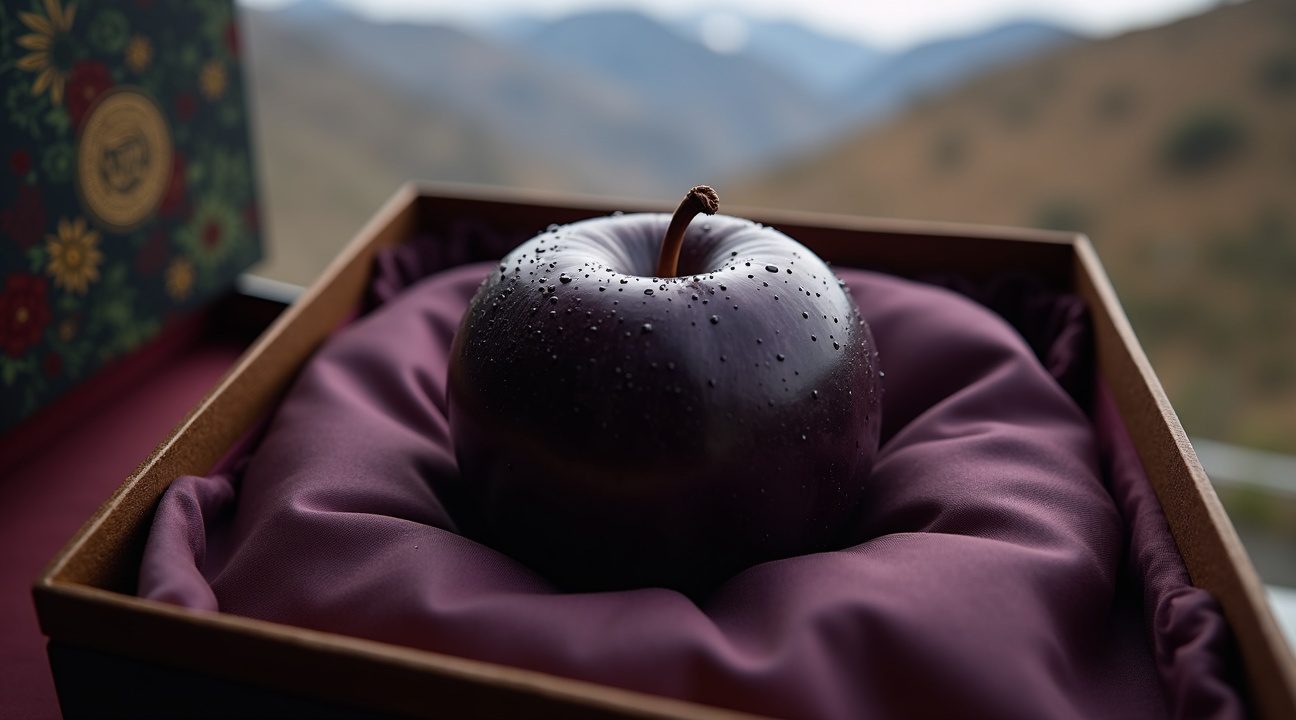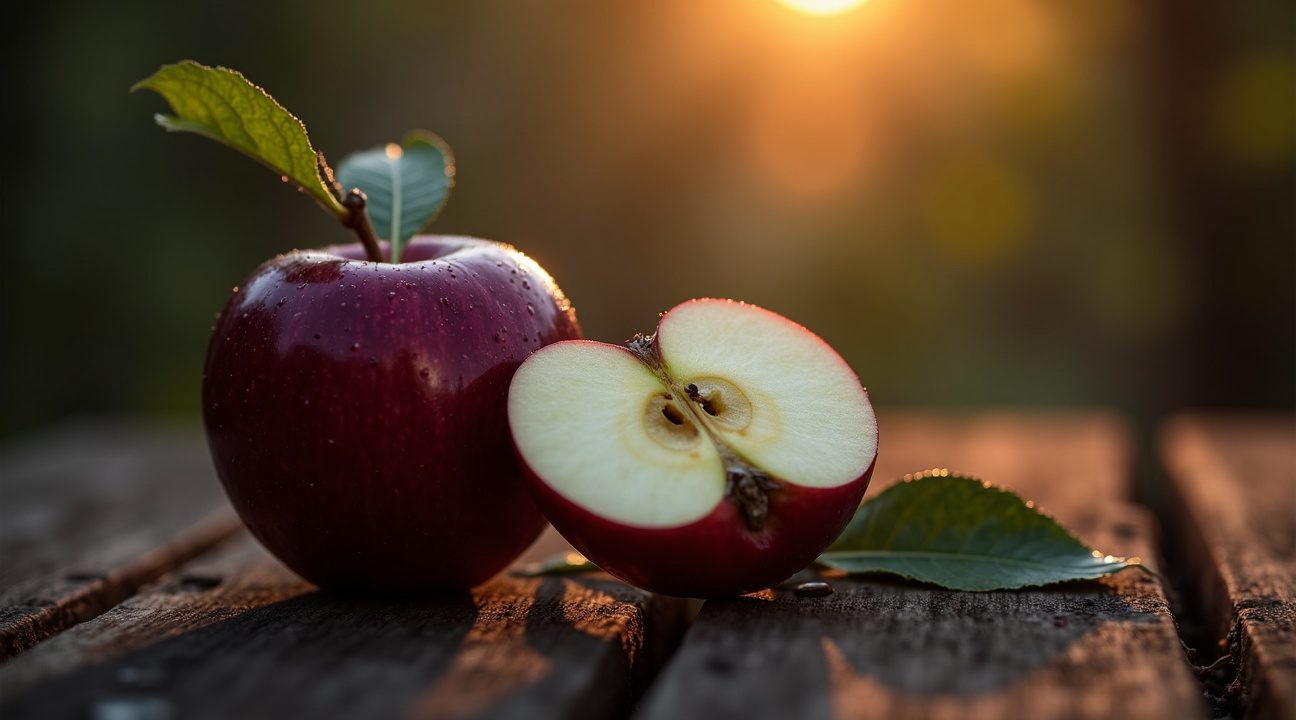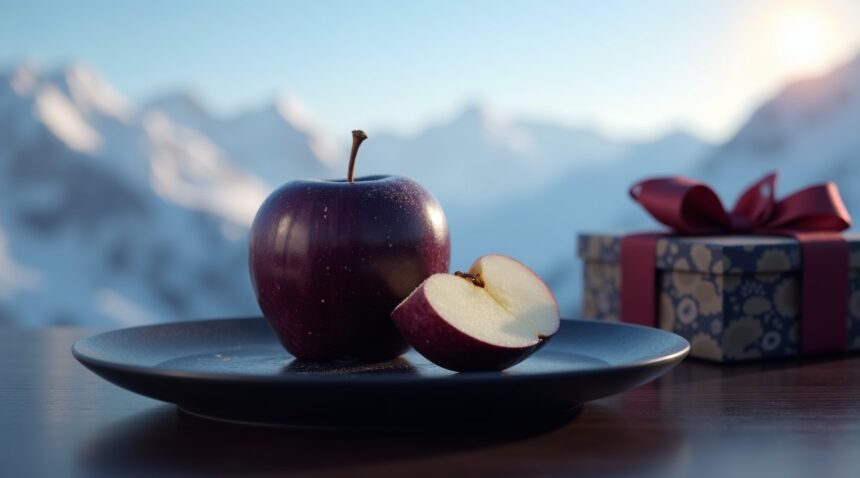Black Diamond apples represent an extraordinary Hua Niu variety that grows exclusively in Tibet’s Nyingchi region, commanding premium prices exceeding $7 per fruit due to their unique dark purple-black appearance and limited cultivation requirements.
Key Takeaways
- Exclusive origin in Nyingchi, Tibet: These apples flourish only under the region’s high-altitude, high-UV, and temperature-variant conditions, which promote intense anthocyanin production, giving the fruit its dark skin.
- Luxury market positioning: Prices often exceed $7 per apple, justified by limited yields, specialized growth needs, and a focus on high-end consumers over mass production.
- Developed naturally: Derived from the Hua Niu apple through traditional breeding, Black Diamond apples arose from environmental adaptation rather than genetic engineering.
- Exceptional taste and nutrition: With 1.86% sugar and just 0.08% acidity, these apples are noted for their dessert-like flavor, along with enhanced antioxidant benefits from dense anthocyanin levels.
- Sensitive storage requirements: Due to their delicate structure and poor storability, they must be eaten fresh within days and cannot be reliably processed or refrigerated long-term.
Environmental Conditions Create a Unique Apple
The Black Diamond apple owes its dark purple-black skin and rich nutritional properties to the extreme environmental variables found only in Tibet’s Nyingchi region. At altitudes above 3,500 meters, UV exposure is much more intense, and dramatic temperature swings between day and night stimulate high anthocyanin production. This process provides the deep coloration and antioxidant profile that distinguishes these apples.
Anthocyanins act as a biochemical shield, helping the apples resist ultraviolet damage. However, the beneficial stress conditions that produce such compounds do not exist elsewhere. Commercial efforts to grow this variety outside Tibet have failed because the complex combination of altitude, sunlight, soil composition, and climate is virtually impossible to replicate artificially.
Limited Supply Drives Premium Pricing
The exclusivity of the Black Diamond’s origins contributes directly to its premium value. Only small orchards in designated parts of Nyingchi can grow the apples, and even then, tree yields are small. These restrictions naturally curb supply, keeping prices high and reserving the apples’ status for elite markets.
Unlike mass-market apples, Black Diamond fruits are marketed as premium experiences. They are carefully graded by size, color, and surface perfection. The darkest, most flawless specimens become luxury gifts or are featured in high-end fruit boutiques in large cities.
Flavor Profile and Nutritional Value
Black Diamond apples are recognized not only for their appearance but also for their rich, dessert-like flavor. With extremely high sugar content and minimal acidity, the fruit appeals to those looking for indulgent, balanced sweetness. Its crisp texture and subtle floral undertones reflect the stress-induced concentration of sugars and nutrients.
Nutritionally, Black Diamond apples offer more than traditional apples. Their elevated anthocyanin levels give them superior antioxidant activity, which has been linked to cardiovascular benefits and anti-inflammatory effects. The pigmentation is a visible marker of the health-promoting compounds within the fruit.
Storage and Consumption Guidelines
Due to their fragile structure, Black Diamond apples must be consumed quickly. Unlike standard apples, they cannot endure refrigerated shipping or extended storage. They begin to degrade after 72 hours, which limits their availability outside select markets and makes them a “buy and eat” product rather than a pantry staple.
Because of this sensitivity, any processing into juices or dried forms is discouraged. The anthocyanins responsible for pigmentation are heat-sensitive and degrade with cooking, nullifying many of the apple’s distinctions. For full nutritional and sensory benefits, these apples must be enjoyed fresh and whole.
Market Reach and Authenticity
Despite the logistical challenges, demand for Black Diamond apples continues to rise, especially in high-income urban centers throughout China. Exportation remains limited due to regional restrictions and transportation issues. Authentic fruits can be difficult to obtain outside these areas, adding to their mystique and exclusivity. For a deeper look at this phenomenon, see this Atlas Obscura article on Black Diamond Apples.
Replication efforts in controlled environments fail primarily due to the biological specificity of the growing conditions required. Because these apples emerged through regional adaptation of the Hua Niu variety, their development supports traditional natural breeding methods. This further appeals to health-conscious consumers wary of genetically modified produce.
Challenges and Sustainability
Farmers interested in growing Black Diamond apples must invest heavily and wait years before trees become productive. Additionally, local weather patterns can significantly impact yearly yields, and profit relies heavily on consistent fruit quality. Orchards rarely meet existing demand and often establish waitlists for their produce.
Looking ahead, the future of Black Diamond apples hinges on the ability to preserve Nyingchi’s unique environment. As climate change threatens altitude-specific weather conditions, both scientists and farmers continue to explore adaptive strategies to protect and sustain this remarkable fruit—as one of agriculture’s most exclusive and naturally developed luxury offerings.
Why These Almost-Black Apples Cost More Than $7 Each
Black Diamond apples command extraordinary prices that often exceed $7 per fruit, positioning them among the world’s most expensive apple varieties. I find their premium pricing reflects a deliberate market strategy that capitalizes on exclusivity rather than volume sales.
The limited supply drives much of the price premium. Production remains insufficient to satisfy global demand because these apples require extremely specific environmental conditions that exist only in select regions of Tibet and China. The high-altitude climate, unique soil composition, and precise temperature fluctuations create growing conditions that can’t be replicated elsewhere, naturally restricting cultivation zones.
Luxury Positioning and Market Strategy
Rather than pursuing mass market appeal, producers position Black Diamond apples as luxury items and premium gifts. The marketing approach deliberately emphasizes rarity and exclusivity, similar to how China releases new digital yuan strategy focuses on controlled distribution. Within China’s domestic market, these apples serve as status symbols, often given as expensive gifts during important occasions or business relationships.
The international market embraces the same luxury positioning. Specialty fruit retailers and high-end grocery stores stock Black Diamond apples alongside other premium produce items, creating an association with quality and sophistication. The striking visual appearance — with skin so dark it appears almost black — reinforces the perception of uniqueness that justifies the premium pricing.
Several factors contribute to maintaining these elevated prices:
- Limited growing regions restrict total production capacity
- Extended growing seasons require more resources and time investment
- Careful harvesting and handling processes increase labor costs
- Premium packaging and shipping methods preserve fruit quality during transport
- Brand positioning as a luxury item rather than everyday produce
The rare fruit market category accommodates consumers willing to pay premium prices for unique experiences. Black Diamond apples fit perfectly into this segment, where price becomes less important than the exclusivity factor. Collectors of rare fruits and affluent consumers seeking distinctive gifts form the primary customer base.
Supply chain economics also influence pricing. The journey from remote Tibetan orchards to international markets involves specialized transportation and storage requirements. These apples need careful temperature control and protective packaging to maintain their distinctive appearance and flavor profile, adding significant costs throughout the distribution process.
Market positioning deliberately avoids competing with standard apple varieties. Instead, Black Diamond apples occupy a niche that compares more closely with luxury foods like premium saffron, aged balsamic vinegar, or rare truffles. The comparison isn’t with other apples but with exclusive culinary experiences that justify premium pricing through scarcity and uniqueness.
The psychological aspect of pricing plays a crucial role. Higher prices reinforce the perception of quality and exclusivity, creating a self-reinforcing cycle where premium pricing actually enhances desirability among target consumers. This strategy works particularly well in markets where conspicuous consumption and gift-giving traditions value expensive, rare items.
Production economics support the high-price strategy. With limited growing capacity and significant investment requirements, producers need substantial profit margins per fruit to justify continued cultivation. The alternative — attempting mass production — would likely compromise the unique characteristics that make these apples special while requiring infrastructure investments that current growing regions can’t support.
International demand continues growing faster than production capacity, maintaining upward pressure on prices. As awareness spreads through social media and luxury food networks, more consumers discover Black Diamond apples, but supply constraints prevent price moderation through increased availability.
The pricing strategy succeeds because it aligns with consumer expectations for rare, authentic products. Buyers understand they’re purchasing more than fruit — they’re buying exclusivity, conversation pieces, and access to something genuinely uncommon in global markets.

The Secret Behind Their Mysterious Dark Purple Skin
Black Diamond apples captivate consumers with their deep purple skin that appears nearly black under certain lighting conditions. This extraordinary coloration stems from an exceptionally high concentration of anthocyanins, powerful natural compounds that create the red, blue, and purple pigmentation found throughout the plant kingdom.
Understanding Anthocyanins and Their Role
Anthocyanins serve as natural antioxidants within the apple’s cellular structure, offering protection against environmental stressors while delivering impressive visual appeal. The dense concentration of these pigments in Black Diamond apples far exceeds what’s found in standard apple varieties, creating their signature dark appearance that commands premium prices in specialty markets.
These remarkable compounds don’t just contribute to aesthetics – they actively enhance the apple’s nutritional profile. Research suggests that foods rich in anthocyanins provide substantial antioxidant benefits, making Black Diamond apples particularly valuable for health-conscious consumers. The pigments also appear to intensify the apple’s natural sweetness, creating a more complex flavor profile than traditional varieties.
The anthocyanin concentration in Black Diamond apples develops through specific growing conditions unique to their high-altitude Tibetan origins. Cool nighttime temperatures combined with intense daytime sunlight trigger the production of these protective compounds, resulting in the distinctive coloration that sets them apart from conventional apples.
Farmers and distributors have discovered that this unique appearance creates significant marketing advantages. The striking visual contrast between the dark exterior and crisp white flesh generates consumer curiosity and justifies premium pricing in international markets. Food photographers and chefs particularly value these apples for their dramatic presentation possibilities.
I’ve observed that the anthocyanin content varies slightly based on harvest timing and storage conditions. Apples picked at peak ripeness display the most intense coloration, while proper cold storage helps maintain the pigment integrity throughout distribution. This attention to timing and handling ensures that consumers receive the full visual and nutritional benefits these compounds provide.
The concentration of anthocyanins also correlates with the apple’s shelf life, as these natural preservatives help protect against oxidation and decay. This characteristic makes Black Diamond apples particularly appealing to retailers who want to minimize product loss while offering customers something truly exceptional.
Understanding the science behind their coloration helps explain why Black Diamond apples command such high prices and generate intense consumer interest. The combination of visual appeal, enhanced nutrition, and improved flavor creates a premium product that stands out in an increasingly crowded apple market.

Why Tibet is the Only Place These Apples Can Grow
I’ve discovered that Black Diamond apples can only thrive in one specific location on Earth: Nyingchi, Tibet. This isn’t a marketing gimmick or geographic coincidence—it’s pure science. The region’s extraordinary environmental conditions create the perfect storm for producing these dark-pigmented fruits that can’t be replicated anywhere else.
The Science Behind the Black Pigmentation
The apple’s signature dark purple-black skin develops through a fascinating interaction between genetics and environment. High-altitude conditions in Nyingchi expose the fruit to intense ultraviolet radiation during the day, while nighttime temperatures plummet dramatically. This extreme temperature variation triggers the production of anthocyanins—the same compounds that make blueberries blue and red wine red—but in concentrations so high they turn the apple’s skin nearly black.
I’ve learned that attempts to grow this Hua Niu variety at lower elevations consistently fail to produce the distinctive coloration. Farmers who’ve tried cultivating these apples in standard orchards end up with fruit that looks remarkably similar to Red Delicious apples. The intense UV exposure at Tibet’s elevation of over 3,000 meters simply can’t be replicated at sea level.
Environmental Requirements That Can’t Be Faked
Nyingchi’s climate creates conditions that agricultural scientists describe as nearly impossible to duplicate artificially. The region experiences over 3,000 hours of sunshine annually, combined with nighttime temperatures that can drop below freezing even during growing season. This creates stress on the apple trees that forces them to concentrate sugars and develop the intense pigmentation.
The harvest window adds another layer of complexity to cultivation. Farmers must pick these apples between late October and early November—a narrow timeframe of just two to three weeks. Miss this window, and the fruit either doesn’t develop proper coloration or begins to deteriorate. The combination of altitude stress, UV exposure, and precise timing means that even within Tibet, successful Black Diamond production remains limited to specific microclimates around Nyingchi.
Production volumes stay deliberately low due to these harsh growing conditions. Each tree produces significantly fewer fruits than conventional apple varieties, and the environmental stress that creates the distinctive appearance also limits overall yield. This natural scarcity, combined with the inability to expand cultivation to other regions, has positioned Black Diamond apples as one of the world’s most exclusive fruits—a status that remains protected by geography itself rather than human intervention.
From Chinese Red Delicious to Tibetan Black Diamond
Black Diamond apples trace their remarkable lineage back to the 1950s when Chinese agricultural scientists created the Hua Niu variety in Tianshui. This groundbreaking hybrid emerged from careful crossbreeding of Red Delicious, Golden Delicious, and Ralls Janet apples in 1956, specifically in Huaniu town where the variety earned its name.
The Rise of Hua Niu Apples
Hua Niu apples, commonly called Chinese Red Delicious, gained national prominence through an unexpected endorsement in 1965. Chairman Mao received samples of these apples and praised their exceptional flavor, which dramatically boosted their reputation across China. This recognition established Hua Niu as one of China’s premier apple varieties and laid the foundation for future developments.
Traditional Breeding Creates the Black Diamond
Black Diamond apples represent a natural evolution of the Hua Niu variety through selective breeding rather than genetic modification. Tibetan farmers developed this unique variant by utilizing traditional agricultural methods combined with Tibet’s harsh mountain climate. The extreme conditions create specific growing challenges that producers must navigate carefully. High altitude, intense UV radiation, and dramatic temperature fluctuations contribute to the apple’s distinctive dark purple-black skin.
These environmental factors work together to produce the Black Diamond’s signature characteristics. Tibet’s thin atmosphere allows more solar radiation to reach the fruit, while the significant temperature differences between day and night stress the apple trees in beneficial ways. This natural stress response triggers increased anthocyanin production, resulting in the deep, dark coloration that gives Black Diamond apples their name.
The selective breeding process focuses on identifying trees that produce the darkest, most flavorful fruit under these challenging conditions. Farmers choose parent trees based on their ability to develop intense coloration while maintaining the sweet, crisp texture inherited from their Hua Niu ancestry. This traditional approach requires patience and expertise, as growers must evaluate multiple generations of trees before achieving consistent results.
Unlike modern agricultural techniques that might rely on chemical treatments or advanced technology, Black Diamond cultivation depends entirely on natural processes. The variety maintains the genetic foundation of its Hua Niu predecessors while expressing unique traits that emerge only under Tibet’s specific growing conditions. Each Black Diamond apple represents decades of careful cultivation and the perfect marriage between Chinese agricultural innovation and Tibetan environmental conditions.

Taste and Nutritional Benefits Beyond Regular Apples
I find the Black Diamond apple’s flavor profile remarkably distinctive, offering a sweetness that rivals or surpasses standard Red Delicious varieties. This exceptional sweetness stems from notably high sugar concentrations that make each bite satisfying and memorable. The crisp texture provides a perfect balance, creating an eating experience that justifies the apple’s premium status.
Superior Sweetness and Low Acidity Profile
The underlying Hua Niu variety demonstrates impressive soluble solids content ranging between 12.5% and 14%, while sugar levels reach approximately 1.86%. These measurements translate directly into the intense sweetness that distinguishes Black Diamond apples from conventional varieties. What makes this sweetness particularly appealing is the low malic acid content of roughly 0.08%, which creates a mellow, sweet profile without the sharp tartness found in many apple varieties.
This unique combination of high sugar and low acid creates what I consider an almost dessert-like eating experience. The reduced acidity allows the natural sweetness to dominate, making these apples especially appealing to those who prefer milder fruit flavors. Just as beverage formulations balance sweetness and acidity for optimal taste, the Black Diamond apple naturally achieves this perfect equilibrium.
Beyond their exceptional taste, Black Diamond apples contain an abundance of beneficial compounds that set them apart nutritionally. I’ve learned that these apples are rich in anthocyanins, the same compounds responsible for their distinctive dark coloration. These powerful antioxidants provide potential health benefits that extend far beyond basic nutrition.
The concentration of polyphenols and phenolic compounds in Black Diamond apples exceeds levels found in typical apple varieties. These compounds contribute to the fruit’s antioxidant properties and may support overall health through their anti-inflammatory effects. While all apples contain these beneficial compounds, the unique growing conditions in Tibet’s high-altitude environment appear to concentrate these nutrients more effectively.
Fresh consumption remains the optimal way to enjoy Black Diamond apples, preserving both their delicate texture and nutritional benefits. Their rarity and specialized growing requirements make them unsuitable for commercial processing or extended storage periods. This limitation actually works in favor of consumers, as fresh consumption maximizes the retention of heat-sensitive compounds like vitamin C and delicate antioxidants.
The texture deteriorates relatively quickly compared to storage varieties, making immediate consumption essential for the best experience. I recommend enjoying these apples within days of purchase to fully appreciate their crisp texture and complex flavor profile. Unlike technological products that improve with updates, these natural gems perform best in their original, unprocessed state.
Storage challenges also mean that Black Diamond apples won’t maintain their quality through traditional preservation methods like freezing or dehydration. The cellular structure that creates their appealing crispness breaks down under processing conditions, resulting in a mushy texture that doesn’t represent the fresh fruit’s quality.
Temperature sensitivity further limits storage options, as these apples perform best at specific refrigeration temperatures for short periods. Extended cold storage can alter the delicate balance of sugars and acids that creates their signature taste profile. Much like how economic developments require specific conditions to succeed, Black Diamond apples need precise environmental factors to maintain their exceptional qualities.
The nutritional superiority combined with limited availability makes Black Diamond apples a premium fresh fruit choice. Their concentrated antioxidant content, exceptional sweetness, and unique growing origins create a product that delivers both sensory pleasure and potential health benefits.
For those fortunate enough to access these rare apples, immediate fresh consumption provides the optimal way to experience their full range of benefits.
How Black Diamonds Compare to Other Premium Apples
Black Diamond apples create an immediate visual impact that sets them apart from their apple relatives. I notice their nearly black, deep purple skin creates a striking contrast against the deep red coloring of standard Hua Niu apples and the familiar bright red appearance of Red Delicious varieties. This dramatic difference isn’t just skin-deep—it reflects fundamental distinctions in cultivation, rarity, and nutritional composition.
Geographic Origins and Cultivation Differences
The cultivation story reveals why Black Diamond apples command such attention in premium fruit markets. These extraordinary apples grow exclusively in the high-altitude region of Nyingchi, Tibet, where specific environmental conditions create their unique characteristics. Hua Niu apples, by comparison, thrive primarily in China’s Gansu and Shanxi provinces, while Red Delicious varieties flourish in apple-growing regions worldwide.
This geographic limitation directly impacts availability and pricing. Black Diamond apples represent the pinnacle of rarity among premium apple varieties, surpassing even the limited availability of Hua Niu apples. Red Delicious varieties, being globally cultivated, remain readily accessible in most markets throughout the year. China’s agricultural innovations have helped maintain consistent quality across these different apple varieties, though location-specific growing conditions remain crucial.
Nutritional Content and Physical Properties
The anthocyanin content tells a compelling story about what makes each variety special. Black Diamond apples contain exceptionally high levels of these powerful antioxidants, which directly contribute to their distinctive dark appearance and complex flavor profile. Hua Niu apples also demonstrate high anthocyanin content, though not quite reaching the concentrated levels found in Black Diamonds. Red Delicious varieties contain moderate anthocyanin levels, sufficient to maintain their red coloring but lacking the intensity found in their premium counterparts.
These differences in anthocyanin concentration affect more than appearance. I find that higher levels typically correlate with enhanced antioxidant benefits and more complex flavor development. The deep purple pigmentation in Black Diamond apples indicates a concentration that rivals some of the most antioxidant-rich fruits available.
Size and storage characteristics present interesting similarities despite the varieties’ other differences:
- Black Diamond apples typically reach medium-to-large proportions, matching premium consumer expectations.
- Storage requirements remain similarly challenging across all three varieties.
- Perishability is comparable among the varieties, necessitating proper refrigeration and handling.
The flavor profiles diverge significantly from what visual appearance might suggest. While traditional fruit flavors often correlate with color intensity, Black Diamond apples deliver a surprisingly sweet taste with subtle complexity rather than the tart notes one might expect from their dramatic appearance. Hua Niu apples provide a balanced sweet-tart combination, while Red Delicious varieties offer the familiar mild sweetness that has made them a global standard.
Market positioning reflects these fundamental differences in rarity, cultivation requirements, and nutritional content:
- Black Diamond apples command premium pricing due to their limited growing region and exceptional anthocyanin content.
- Hua Niu apples occupy a middle tier in specialty markets, combining quality with greater accessibility.
- Red Delicious apples serve as the widely available, affordable standard.
Understanding these comparisons helps explain why Black Diamond apples have captured attention among fruit enthusiasts and health-conscious consumers. Their combination of visual drama, nutritional density, and cultivation rarity creates a unique position in the premium apple market that neither Hua Niu nor Red Delicious varieties can replicate.
Sources:
Helm Infinity article: “8+ Exotic Black Pearl Diamond Apple Types & More!”
Kiddle Encyclopedia: Huaniu Facts for Kids
Threads.com post: “Black Diamond apples are a rare and striking variety of Hua Niu apples”
PMC article: “Optimization of the Fermentation Conditions of Huaniu Apple Cider…”
Pomiferous: Black Diamond
Arad Branding: “Introducing Black Diamond Apple + the Best Purchase Price”
China Daily: “Apples from Gansu find favor in global markets”


